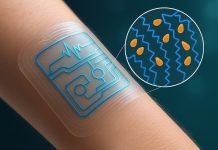
Scientists have made a breakthrough in developing an electronic skin that mimics the complex 3D structure and touch sensitivity of human skin.
This new technology, led by Professor Yihui Zhang from Tsinghua University, has the potential to revolutionize various fields, including biomedical diagnosis and robotics.
Human skin has amazing sensing capabilities, which scientists have long tried to replicate.
However, recreating the intricate 3D microstructure of human skin has been a significant challenge.
The team at Tsinghua University has now succeeded in creating a three-dimensionally architected electronic skin (3DAE-Skin) that can accurately sense normal force, shear force, and strain separately.
Inspired by human skin, the researchers designed the electronic skin with force and strain sensing components arranged in a 3D layout.
This design mimics the arrangement of Merkel cells and Ruffini endings found in human skin, which are responsible for touch sensitivity. The result is the first electronic skin of its kind that can fully decouple and measure different types of forces and strains.
Using artificial intelligence, the team also developed a tactile system that can measure the modulus (stiffness) and curvature of objects through touch.
They demonstrated this technology by quickly measuring the firmness and freshness of fruits, bread, and cake of various shapes.
This capability has significant potential applications, such as assessing the freshness of food, diagnosing medical conditions, and improving the functionality of humanoid robots and prosthetic limbs.
The study, published in the journal Science, involved collaboration with colleagues from Tsinghua University’s Applied Mechanics Laboratory, Department of Engineering Mechanics, and Laboratory of Flexible Electronics Technology.
This advanced electronic skin represents a significant step forward in the field of touch-sensitive technologies.
It opens up new possibilities for creating more sophisticated and sensitive artificial systems that can interact with the world in ways similar to human touch.
With applications ranging from healthcare to robotics, this innovation could lead to significant improvements in various technological and medical fields.



